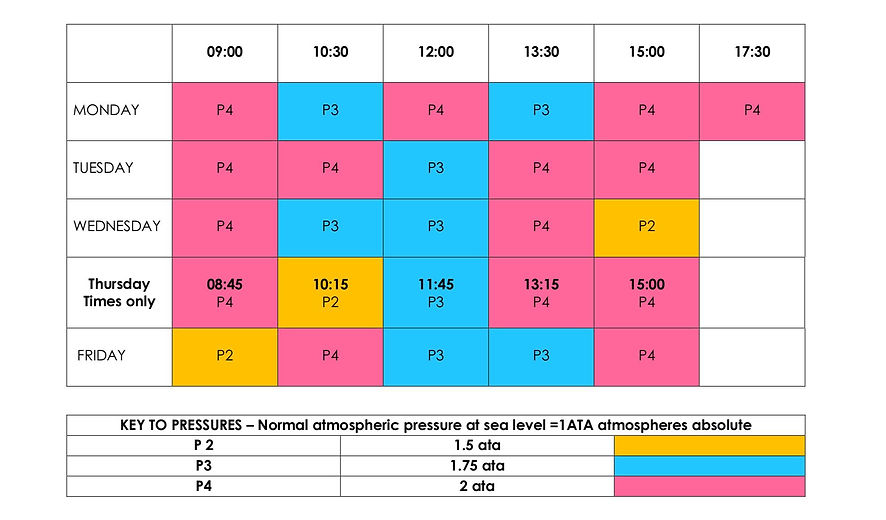Oxygen Therapy
What is oxygen therapy?
Oxygen therapy can be referred to as either Hyperbaric Oxygen Therapy (HBOT) or High Dose Oxygen Therapy (HDOT). This means that during your therapy session, you will be breathing in a higher concentration of oxygen whilst under increased atmospheric pressure (hyperbaric). Since August 2022, we have been generating our own oxygen, which guarantees supply and quality.
What conditions can benefit?
The majority of our members and Centre users live with chronic neurological conditions, predominantly Multiple Sclerosis (MS). Other conditions include; Chronic Fatigue Syndrome (CFS), Myalgic Encephalomyelitis (ME), Motor Neurone Disease (MND), Parkinson's, Stroke and Fibromyalgia.

Our hyperbaric oxygen chamber
Oxygen therapy for Non Neurological conditions
We also offer non-subsidised sessions for those wanting to benefit from our therapies who may not have a neurological condition..
These include
-
Acute illness
-
·Injury, including sports and trauma.
-
Post operative recovery
-
Long Covid
-
Cancer
-
Arthritis
-
If your issue/condition is not on this list, please call us to discuss it, we will be delighted to help.
These users will still have use of our facilities in the same way, but pay through Bristol Therapy Centre Ltd.
Click here for an application form for non-neurological service users.
Oxygen therapy for sports professionals
%20and%20Joe%20Joyce%20(LHS)%20from%20Bristol%20Bears%20Rugby.jpg)
Max Lahiff and Joe Joyce, Bristol Bears
We frequently assist those with a variety of sports injuries. In the past, we have treated players from both amateur and professional football and rugby clubs as well as professional cricketers and ice hockey players. Due to an increased level of fitness in sportspeople, the number of sessions they require in the chamber is reduced. Oxygen therapy is particularly beneficial for speeding up the repair of strains, breaks and soft tissue damage.
Click here to complete a form specifically to book sessions for sports-related injuries.
The air we normally breathe contains 21% oxygen, and 78% nitrogen, with the remaining 1% being contributed by noble gases and carbon dioxide. The concentration of these gases is determined by the atmospheric pressure which is influenced by the weather and is reduced at altitude. Atmospheric pressure is accorded the unit 1 to represent atmospheric pressure absolute, or 1 ATA.
How does oxygen therapy work?

Oxygen timetable
Please note the timetable can occasionally change due to demand, check with the oxygen team to confirm the correct timings and pressure.

Isobaric and Exercise with Oxygen Sessions
There are no set time for sessions on the outside of the Chamber - an appointment is required.
Further Information about your therapy
In instances where it isn’t feasible to attend every day, we will work with you to organise sessions as close together as possible to maximise the potential effectiveness of the therapy.
When in the chamber we recommend that you wear comfortable, loose-fitting clothes. Some people find it beneficial to wear layers as the chamber can become quite warm during a session and can then become quite chilly during decompression. You can take a mask break while in the chamber as long as it is only one member at a time
When the pressure increases in the chamber you may need to equalise your ears, just as you would on an aeroplane. There are a number of ways to do this:
• Swallow; this is usually the most effective method
• Pinch your nose and with your mouth shut blow out
• Move your jaw from side to side
• Try to force a yawn
• Take sips of water; you will need to bring a plastic bottle of still water with you
If you can’t clear your ears at first, don't worry, just let the operator know straight away and they will stop the pressurisation, they'll then let out some of the pressure until you let them know, with a thumbs up, that everything is okay, the operator will then resume pressurisation at a slower rate. The operator, and the other occupants of the chamber, will always be on hand to help you.
As you will be wearing your mask for the entirety of the session it will be difficult to talk and the noise will make it tricky to hear. Most people listen to something through their headphones or read a book to keep themselves entertained. You can bring your mobile phone, tablet or laptop into the chamber; but we recommend you download any programmes you’d like to watch beforehand. There is free Wi-Fi in the Centre, so you could do a spot of online shopping to pass the time.
There are a number of items that are prohibited to have in the Chamber please click here for full details.
Meet the Team

For further information about The Brightwell Community please visit the following pages
What to do next
We very much hope that you would like to Become a Member.
More information about costs and ways to pay can be found on our Therapies page
Our Reception Team will be delighted to help you with any questions, please callron 01454 201686
We look forward to welcoming you to The Brightwell.















